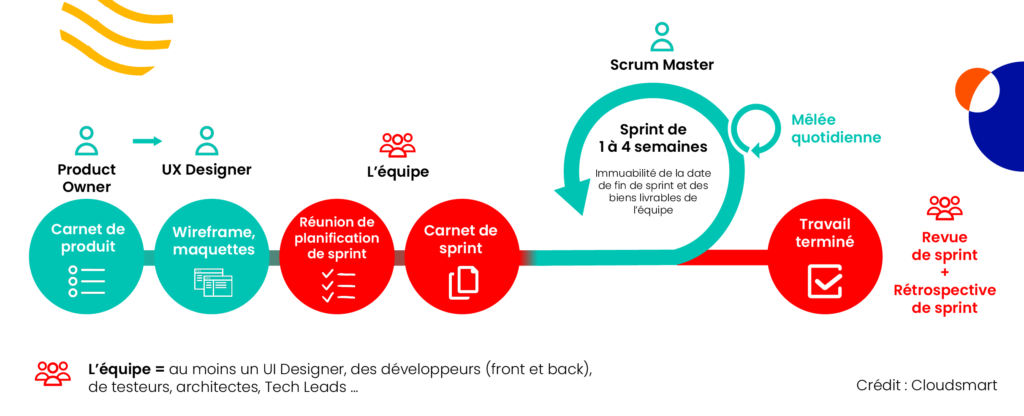Before delving into the heart of the matter, let's take a moment to look at the history of the emergence of these roles.
The concept of agility and the various associated methods have introduced numerous principles and best practices since the 1990s. These methods have also brought about new roles in the realm of project management, while others have been displaced. One of the roles introduced by agility, specifically by Scrum, which has recently garnered significant interest, is that of the Product Owner.
The field of UX Design has also made quite a buzz since its origins in the 1940s within Toyota's factories. Initially focused on enhancing Human value in testing processes, UX Design underwent modernization in the 2000s. Since then, we have seen a proliferation of digital projects and a significant exposure of roles such as UX Designers and UI Designers.
In this article, we will explore the activities of the Product Owner on one hand and those of a UX Designer and its counterpart, the UI Designer, on the other. This insight into these roles will allow us to subsequently analyze the interest and contributions of collaboration between them.
The Product Owner according to SCRUM
The Product Owner, as described in Scrum, seems to be a superhero of product and project management. They are visionary, master their product, anticipate its contributions from a monetary perspective... Indeed, they make every effort to provide the most value possible for the business within the project's timeframe. They hold the wildcard: the "NO" card, which they don't hesitate to use to protect their team and ensure the achievement of their goals. The Product Owner is also very meticulous in describing what needs to be produced. They leave nothing to chance and ensure the involvement of the entire team, setting the tone. So many activities included in their job description leave them with no time for respite.
Yes, the Product Owner as described in Scrum is a superhero, and in everyday life, it is unlikely that we would encounter one.

And even if that were to happen, let us remember that a superhero always needs allies. What would Batman be without Robin?
And what if the best ally of the Product Owner were the UX designer?
Who is the UX Designer?
As the name suggests, the UX designer is responsible for the design (conception) of the user experience. They seek to maximize the experience the user has with a product/service, making it memorable.
The keywords for a UX designer are usability, accessibility, and desirability. This is far from the legendary triptych of project management: quality, cost, and time. This is entirely normal because a UX designer is primarily interested in the user. The UX Designer brings the most value upstream in projects. They gather data about the user: who they are, their environment, their habits, their behavior towards our product. They use tools such as personas, the Empathy Map, or the User Journey Map for this purpose.
The UX Designer identifies the user's needs and imagines solutions. They bring their solutions to life in the form of wireframes and prototypes. It is after this stage that the UI Designer intervenes.
UX Designer, UI Designer: Same battle?
The UI Designer designs the user interface, which is the access point through which the user will experience this memorable experience. Their goal is to make aesthetics useful. Therefore, they create pleasant, practical, and easy-to-use interfaces. The UI Designer works on perceptible elements: typography, graphic elements, buttons, navigation...
They are highly appreciated and essential for digital projects, which often rely heavily on interfaces and their aspects. This is where there is often confusion, as UX Design has often been reduced to the creation of "beautiful" user interfaces. This is a gross mistake! UI Design is a sub-discipline of UX Design. Often, the same person performs both activities. Nevertheless, they are distinct.
Ultimately, UX and UI Designers have the same objective: to provide the best possible experience to the user. They are constantly in touch with the user to test the solutions and incorporate their feedback for iteration.
Product Owner – UX Designer, the Dynamic Duo
In theory, the Product Owner is also in contact with users and all stakeholders in the project to ensure that no need is neglected. However, in practice, even with all the goodwill that a Product Owner possesses, it is difficult for them to carry out this observation and understanding of the user's work with as much precision as a UX Designer.
Let us recall that the PO's goal is to satisfy the client (business) and indirectly the user. They primarily interact with business stakeholders and seek to elicit their users' needs. The most seasoned Product Owners will use several UX Design tools, such as personas, to understand their users, but they will sorely lack time and skills to complete the exercise.
Therefore, it would be more logical to give credit where it is due. The UX Designer should be allowed to identify User needs, a specialty that belongs to them.
Allowing the UX Designer to focus on the user, while maintaining continuous interactions with the PO, would enable these two roles to define a product that meets users' most unsuspected needs by confronting them with those of clients (business) and other stakeholders.
The Product Owner can then focus on defining Backlog activities, writing and prioritizing user stories, and engaging with stakeholders. They will ensure not only business value but above all user satisfaction. This is the only way the company as a whole will derive value. After all, what is better than a satisfied user?

Such a functioning simply means placing the user at the heart of agile projects. The implementation team, which is multidisciplinary, should then consist of UX and UI Designers, developers (front and back), testers, architects, tech leads, ...

The UX Designer and the Product Owner, therefore, function as a team.




